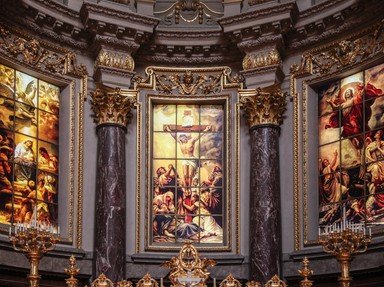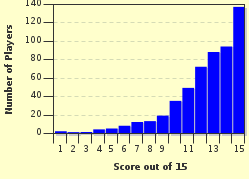Quiz Answer Key and Fun Facts
1. January 3: The patron saint of Paris saved the city three separate times. Who is she?
2. February 13: St. Modomnoc O'Neil was from Ireland but he had to train for the priesthood under St. David at Mynyw Monastery in Wales. All the students in the monastery were required to do manual labor for the monastery. St. Modomnoc happily took charge of something the other students shunned. What was St. Modomnoc O'Neil in charge of that they needed to make mead?
3. March 9: This boy set a record for being the youngest non-martyred saint. This Italian boy died just short of his 15th birthday from what is believed to be pleurisy. Who is the saint whose day is March 9 and who is also the youngest listed?
4. March 25: The "good thief" crucified alongside Jesus was named Gestas.
5. April 16: Born in Lourdes, France, what saint had 18 visions of the Blessed Virgin Mary when she was a young teenager?
6. May 15: St. Isidore is the patron saint of farmers.
7. May 17: Near Madron in Cornwall is the hermitage of St. Madron (or Madern) who lived around 545 AD. There is also a well in that spot. Why do people generally travel to St. Madron's Well?
8. June 13: St. Anthony of Padua, who lived in the early 1200's, once was so disgusted because the people he was preaching to were not listening that he went to the river. What did he preach to at the river instead of his parishioners?
9. July 25: The name of the saint for July 25 means "Christ carrier." This saint is the patron saint of travelers. Who is he?
10. August 8: Catholic tradition says that the Blessed Virgin Mary gave something to St. Dominic in 1214 AD that Catholics pray with to this day. What common Catholic item did Mary supposedly give to St. Dominic in an apparition?
11. September 25: St. Cadoc of Llancarvan founded the Abbey of Llancarvan in 518 AD. The abbey has become a famous center of learning. Based upon the name "Llancarvan" you can probably guess where it is. Where is the Abbey of Llancarvan?
12. October 17: When John Kolobos entered the monastery at Skete in Egypt the abbot could tell the small young man lacked patience. He ordered John to plant his walking stick in the ground and water it twice a day. John did. What reportedly happened to the stick after three years?
13. October 29: St. Colman Kilmacduagh was abbot of Kilmacduagh Monastery near Gort in County Galway, Ireland around the turn of the seventh Century. Colman and the others in the monastery, as monks, were required to pray at certain times of the day including early morning and late night. What were the prayer times called?
14. November 11: Before he was Martin of Tours, Martin was a Roman soldier and the head of an honor guard. One day as he rode into Amiens at the head of a procession he espied a poor beggar dressed in rags shivering by the front city gate. What did Martin share with the man?
15. December 6: It is the custom in Germany, Switzerland and Italy to celebrate this saint's day, December 6, by giving gifts to children. This saint has also come to be associated with Christmas. Which saint is honored on December 6?
Source: Author
deputygary
This quiz was reviewed by FunTrivia editor
CellarDoor before going online.
Any errors found in FunTrivia content are routinely corrected through our feedback system.

